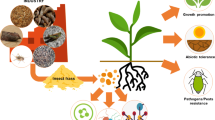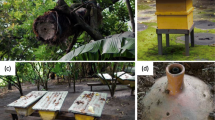Abstract
Spotted lanternfly (SLF) is an invasive insect pest in the northeastern USA, and current projections suggest global spread of this insect. SLF is particularly damaging in grape; however, little is known about SLF activity and phenology in vineyards. In 2018–2019, adult SLF populations were monitored in 7–9 Pennsylvania vineyards using weekly visual assessments of vines. Additional studies were carried out in 2019 to identify the daily activity (e.g., feeding, mating, flying) of SLF adults in vineyards. Weekly monitoring data revealed that adults infested vineyards in late summer and populations peaked in early to mid-September. Nymphs were observed on vines in the spring, but nymphal populations did not persist at high levels throughout the season (< 5 SLF/vine). Prior to harvest, SLF was predominantly found on the shoots, but after harvest, greatest proportions of SLF were found on the trunk. Both feeding and dispersal activity increased throughout the day with greatest proportions of these activities observed in the afternoon and evening compared to morning observations. Daily increases of SLF on vines were positively correlated with SLF dispersal, suggesting high input from the surrounding landscape and potential need for area-wide management of this pest. Understanding seasonal patterns of SLF may improve management of this pest through timing control measures with population influxes both diurnally and seasonally.






Similar content being viewed by others
References
Ascerno ME (1991) Insect phenology and integrated pest management. J Arboricult 17:13–15
Avanesyan A, Maugel TK, Lamp WO (2019) External morphology and developmental changes of tarsal tips and mouthparts of the invasive spotted lanternfly, Lycorma delicatula (Hemiptera: Fulgoridae). PLoS ONE 14(12):e0226995
Barringer LE, Donovall LR, Spichiger SE, Lynch D, Henry D (2015) The first new record of Lycorma delicatula (Insecta: Hemiptera: Fulgoridae). Entomol News 125:20–23
Bates DM, Maechler B, Bolker S Walker (2015) Fitting linear mixed-effects models using lme4. J Stat Softw 67:1–48. https://doi.org/10.18637/jss.v067.i01
Bostanian NJ, Vincent C, Isaacs R (2012) Arthropod management in vineyards: pests, approaches, and future directions. Springer, New York
Candolfi MP, Jermini M, Carrera E, Candolfi-Vasconcelos MC (1993) Grapevine leaf gas exchange, plant growth, yield, fruit quality and carbohydrate reserves influenced by the grape leafhopper. Empoasca vitis. Entomologia experimentalis et applicata 69(3):289–296
Choi DS, Kim DI, Ko SJ, Kang BR, Park JD, Kim SG, Choi KJ (2012) Environmentally-friendly control methods and forecasting the hatching time Lycorma delicatula (Hemiptera: Fulgoridae) in Jeonnam Province. Korean J Appl Entomol 51(4):371–376
Clifton EH, Castrillo LA, Gryganskyi A, Hajek AE (2019) A pair of native fungal pathogens drives decline of a new invasive herbivore. Proc Natl Acad Sci 116(19):9178–9180
Čokl A, Virant-Doberlet M (2003) Communication with substrate-borne signals in small plant-dwelling insects. Ann Rev Entomol 48:29–50
Dara SK, Barringer L, Arthurs SP (2015) Lycorma delicatula (Hemiptera: Fulgoridae): a new invasive pest in the United States. J Integ Pest Manag 6(1):20. https://doi.org/10.1093/jipm/pmv021
Eriksson A, Anfora G, Lucchi A, Lanzo F, Virant-Doberlet M, Mazzoni V (2012) Exploitation of insect vibrational signals reveals a new method of pest management. PLoS ONE 7(3):e32954
Flaherty DL, Christiensen L, Lanini WT (1992) Mealybugs. Grape pest management. Univ Calif Div Agric Nat Res Publ 3343:159–165
Flint ML, Gouveia P (2012) IPM in practice: principles and methods of integrated pest management. University of California Press, Oakland
Geiger CA, Daane KM (2001) Seasonal movement and distribution of the grape mealybug (Homoptera: Pseudococcidae): developing a sampling program for San Joaquin Valley vineyards. J Econ Entomol 94:291–301
Han JM, Kim HJ, Lim EJ, Lee SH, Kwon YJ, Cho SW (2008) Lycorma delicatula (Hemiptera: Auchenorrhyncha: Fulgoridae: Aphaeninae) finally, but suddenly arrived in Korea. Entomol Res 38:281–286
Hellman EW (2003) Grapevine structure and function. Oregon viticulture. Oregon State Univ Press, Corvallis, pp 5–19
Huberty AF, Denno RF (2004) Plant water stress and its consequences for herbivorous insects: a new synthesis. Ecology 85(5):1383–1398
Jung JM, Jung S, Byeon D, Lee WH (2017) Model-based prediction of potential distribution of the invasive insect pest, spotted lanternfly Lycorma delicatula (Hemiptera: Fulgoridae), by using CLIMEX. J Asia-Pac Biodiv 10:532–538
Keller M (2015) The science of grapevines: anatomy and physiology, 2nd edn. Academic Press, Cambridge
Kim SS, Kim TW (2005) Lycorma delicatula (White) (Hemiptera: Fulgoridae) in Korea. Lucanus 5:9–10
Kim IK, Koh SH, Lee JS, Choi WI, Shin SC (2011a) Discovery of an egg parasitoid of Lycorma delicatula (Hemiptera: Fulgoridae) an invasive species in South Korea. J Asia Pac Entomol 14(2):213–215
Kim JG, Lee E, Seo Y et al (2011b) Cyclic behavior of Lycorma delicatula (Insecta: Hemiptera: Fulgoridae) on host plants. J Insect Behav. https://doi.org/10.1007/s10905-011-9266-8
Korner-Nievergelt F, Roth T, von Felten S, Guelat J, Almasi B, Korner-Nievergelt P (2015) Bayesian data analysis in ecology using linear models with R, BUGS and Stan. Elsevier, Amsterdam
Leach H, Biddinger DJ, Krawczyk G, Smyers E, Urban JM (2019) Evaluation of insecticides for control of the spotted lanternfly, Lycorma delicatula,(Hemiptera: Fulgoridae), a new pest of fruit in the Northeastern US. Crop Prot 124:104833
Lee JE, Moon SR, Ahn HG, Cho SR, Yang JO, Yoon C, Kim GH (2009) Feeding behavior of Lycorma delicatula (Hemiptera: Fulgoridae) and response on feeding stimulants of some plants. Korean J Appl Entomol 48:467–477
Lee K, Kim S, Kim I, Kim K (2011) Seasonal occurrence of spot clothing wax cicada, Lycorma delicatula (Hemiptera: Fulgoridae) and it’s control efficacy using EFAM at the vineyards. Korean J Pesticide Sci 15(3):303–309
Lee DH, Park YL, Leskey TC (2019) A review of biology and management of Lycorma delicatula (Hemiptera: Fulgoridae), an emerging global invasive species. J Asia Pac Entomol 22(2):589–596
Lenth R (2018) emmean: Estimated marginal means, aka least-squares means. R Package Version 1.2.3. https://CRAN.R-project.org/package=emmeans
Liu H (2019) Occurrence, seasonal abundance, and superparasitism of Ooencyrtus kuvanae (Hymenoptera: Encyrtidae) as an egg parasitoid of the spotted lanternfly (Lycorma delicatula) in North America. Forests 10(2):79
Myrick AJ, Baker TC (2019) Analysis of anemotactic flight tendencies of the spotted lanternfly (Lycorma delicatula) during the 2017 mass dispersal flights in Pennsylvania. J Insect Behav 32:11–23
Northeastern IPM Center (2019) Distribution maps. www.stopSLF.org. Accessed 11 Jan 2020
Park K, Kim M, Lee S, Shin S, Kim J, Park I (2009) Biological characteristics of Lycorma delicatula and the control effects of some insecticides Korean. J Appl Entomol 48:53–57
Park M, Kim KS, Lee JH (2013) Genetic structure of Lycorma delicatula (Hemiptera: Fulgoridae) populations in Korea: implication for invasive processes in heterogeneous landscapes. Bull Entomol Res 103:414–424
Pedigo LP, Rice ME (2006) Economic decision levels for pest populations. Entomology and pest management. Prentice Hall, Columbus, pp 253–284
Pennsylvania Department of Agriculture (2018) Order of quarantine and treatment; spotted lanternfly. PA Bulletin 48(21): http://www.pacodeandbulletin.gov/Display/pabull?file=/secure/pabulletin/data/vol48/48-21/825.html. Accessed 17 Dec 2019
Song MK (2010) Damage by Lycorma delicatula and chemical control in vineyards. Chunbuk National University, Korea, Agric Biol Appl Entomol
Tomisawa A, Ohmiya S, Fukutomi H, Hayashi K, Ishikawa T (2013) Biological notes on Lycorma delicatula (White)(Hemiptera, Fulgoridae) in Ishikawa Prefecture, Japan. Jpn J Entomol 16:3–14
Urban JM (2019) Perspective: shedding light on spotted lanternfly impacts in the USA. Pest Manag Sci 76:10–17. https://doi.org/10.1002/ps.5619
Wakie TT, Neven LG, Yee WL, Lu Z (2019) The establishment risk of Lycorma delicatula (Hemiptera: Fulgoridae) in the United States and globally. J Econ Entomol 113:306–314. https://doi.org/10.1093/jee/toz259
Acknowledgements
We thank Elizabeth Deecher for her technical assistance and the growers who allowed us access to their vineyards throughout the duration of this study. This work was supported in part by the USDA-APHIS-PPQ under Agreement Number AP19PPQFO000C369 and the Pennsylvania Department of Agriculture under Agreement Number 44144949.
Author information
Authors and Affiliations
Corresponding author
Additional information
Communicated by D.C. Weber.
Publisher's Note
Springer Nature remains neutral with regard to jurisdictional claims in published maps and institutional affiliations.
Electronic supplementary material
Below is the link to the electronic supplementary material.
Rights and permissions
About this article
Cite this article
Leach, H., Leach, A. Seasonal phenology and activity of spotted lanternfly (Lycorma delicatula) in eastern US vineyards. J Pest Sci 93, 1215–1224 (2020). https://doi.org/10.1007/s10340-020-01233-7
Received:
Revised:
Accepted:
Published:
Issue Date:
DOI: https://doi.org/10.1007/s10340-020-01233-7




